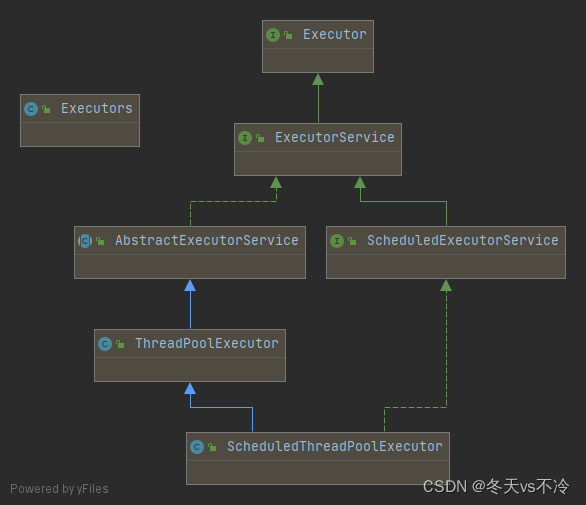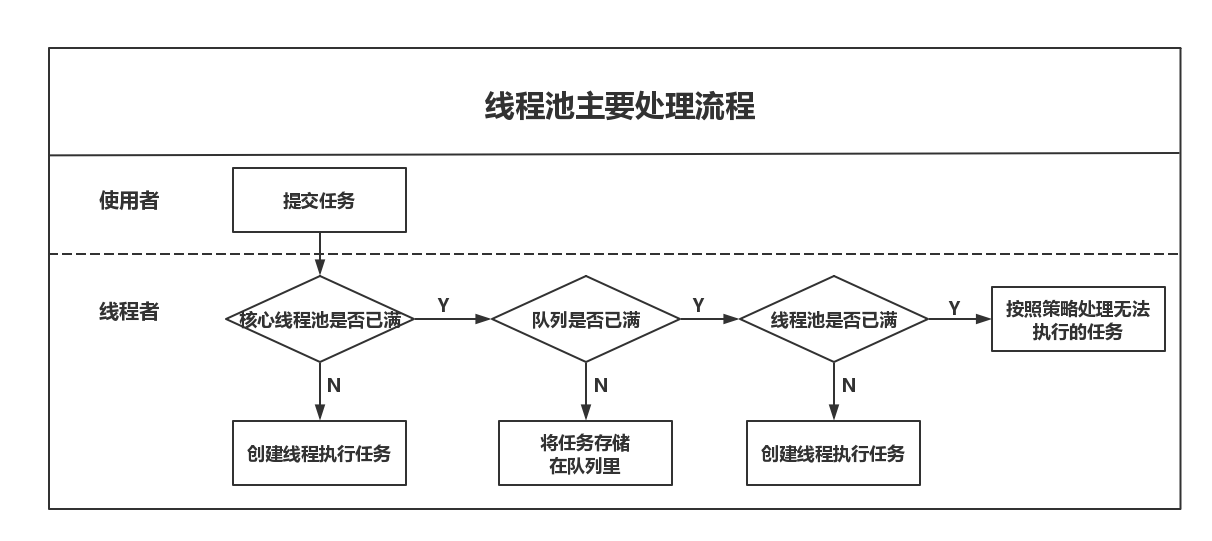Java并发编程之线程池
1、线程池使用及优势
- 线程池做的工作主要是控制运行的线程的数量,处理过程中将任务放入队列
- 然后在线程创建后启动这些任务
- 如果线程数量超过了最大数量超出数量的线程排队等候
- 等其它线程执行完毕,再从队列中取出任务来执行
优点
- 降低资源消耗:通过重复利用己创建的线程降低线程创建和销毁造成的消耗
- 提高响应速度:当任务到达时,任务可以不需要的等到线程创建就能立即执行
- 提高线程的可管理性:线程是稀缺资源,如果无限制的创建,不仅会消耗系统资源,还会降低系统的稳定性,使用线程池可以进行统一的分配,调优和监控
2、线程池3个常用方式
Java中线程池是通过Executor框架实现的,该框架中用到了Executor,Executors(代表工具类),ExecutorService,ThreadPoolExecutor这几个类

了解:
- Executors.newScheduledThreadPool():任务调度,定时
- Executors.newWorkStealingPool(int): Java8新增,使用目前机器上可用的处理器作为它的并行级别
重点:
- Executors.newSingleThreadExecutor()

- 创建一个单线程化的线程池,它只会用唯一的工作线程来执行任务,保证所有任务按照指定顺序执行
- newSingleThreadExecutor将corePoolSize和maximumPoolSize都设置为1,它使用的LinkedBlockingQueue
- Executors.newFixedThreadPool(int)

- 创建一个定长线程池,可控制线程最大并发数,超出的线程会在队列中等待
- newFixedThreadPool创建的线程池corePoolSize和maximumPoolSize值是相等的,它使用的LinkedBlockingQueue
- Executors.newCachedThreadPool()

- 创建一个可缓存线程池,如果线程池长度超过处理需要,可灵活回收空闲线程,若无可回收,则新建线程
- newCachedThreadPool将corePoolSize设置为0,将maximumPoolSize设置为Integer.MAX_VALUE,使用的SynchronousQueue,也就是说来了任务就创建线程运行,当线程空闲超过60秒,就销毁线程
示例
public class ThreadPoolDemo {
public static void main(String[] args) {
// 一池5个处理线程(用池化技术,一定要记得关闭)
ExecutorService threadPool = Executors.newFixedThreadPool(5);
// 创建一个只有一个线程的线程池
// ExecutorService threadPool = Executors.newSingleThreadExecutor();
// 创建一个拥有N个线程的线程池,根据调度创建合适的线程
// ExecutorService threadPool = Executors.newCachedThreadPool();
// 模拟10个用户来办理业务,每个用户就是一个来自外部请求线程
try {
// 循环十次,模拟业务办理,让5个线程处理这10个请求
for (int i = 0; i < 10; i++) {
final int tempInt = i;
threadPool.execute(() -> {
System.out.println(Thread.currentThread().getName()
+ "\t 给用户:" + tempInt + " 办理业务");
});
}
} catch (Exception e) {
e.printStackTrace();
} finally {
//关闭线程池
threadPool.shutdown();
}
}
}运行结果:
pool-1-thread-3 给用户:2 办理业务
pool-1-thread-5 给用户:4 办理业务
pool-1-thread-4 给用户:3 办理业务
pool-1-thread-2 给用户:1 办理业务
pool-1-thread-1 给用户:0 办理业务
pool-1-thread-2 给用户:8 办理业务
pool-1-thread-5 给用户:6 办理业务
pool-1-thread-4 给用户:7 办理业务
pool-1-thread-3 给用户:5 办理业务
pool-1-thread-1 给用户:9 办理业务
Process finished with exit code 03、线程池7大参数
public class ThreadPoolExecutor extends AbstractExecutorService {
...
public ThreadPoolExecutor(int corePoolSize,
int maximumPoolSize,
long keepAliveTime,
TimeUnit unit,
BlockingQueue<Runnable> workQueue,
ThreadFactory threadFactory,
RejectedExecutionHandler handler) {
if (corePoolSize < 0 ||
maximumPoolSize <= 0 ||
maximumPoolSize < corePoolSize ||
keepAliveTime < 0)
throw new IllegalArgumentException();
if (workQueue == null || threadFactory == null || handler == null)
throw new NullPointerException();
this.acc = System.getSecurityManager() == null ?
null :
AccessController.getContext();
this.corePoolSize = corePoolSize;
this.maximumPoolSize = maximumPoolSize;
this.workQueue = workQueue;
this.keepAliveTime = unit.toNanos(keepAliveTime);
this.threadFactory = threadFactory;
this.handler = handler;
}
...
}- corePoolSize:线程池中的常驻核心线程数 1)在创建了线程池后,当有请求任务来之后,就会安排池中的线程去执行请求任务。 2)当线程池中的线程数目达到corePoolSize后,就会把到达的任务放到缓存队列当中
- maximumPoolSize:线程池能够容纳同时执行的最大线程数,此值必须大于等于1
- keepAliveTime:多余的空闲线程的存活时间 1)当前线程池数量超过corePoolSize时,当空闲时间达到keepAliveTime值时,多余空闲线程会被销毁直到只剩下corePoolSize个线程为止
- unit:keepAliveTime的单位
- workQueue:任务队列,被提交但尚未被执行的任务
- threadFactory:表示生成线程池中工作线程的线程工厂,用于创建线程一般用默认的即可
- handler:拒绝策略,表示当队列满了并且工作线程大于等于线程池的最大线程数( maximumPoolSize)
4、线程池底层工作原理


- 在创建了线程池后,等待提交过来的任务请求
- 当调用execute()方法添加一个请求任务时,线程池会做如下判断: 1)如果正在运行的线程数量小于corePoolSize,那么马上创建线程运行这个任务 2)如果正在运行的线程数量大于或等于corePoolSize,那么将这个任务放入队列 3)如果这时候队列满了且正在运行的线程数量还小于maximumPoolSize,那么还是要创建非核心线程立刻运行这个任务 4)如果队列满了且正在运行的线程数量大于或等于maximumPoolSize,那么线程池会启动饱和拒绝策略来执行 5)当一个线程完成任务时,它会从队列中取下一个任务来执行
- 当一个线程无事可做超过一定的时间(keepAliveTime)时,线程池会判断如果当前运行的线程数大于corePoolSize,那么这个线程就被停掉,所以线程池的所有任务完成后它最终会收缩到corePoolSize的大小
5、线程池的4种拒绝策略
等待队列也已经排满了,再也塞不下新任务了同时,线程池中的max线程也达到了,无法继续为新任务服务。 这时候我们就需要拒绝策略机制合理的处理这个问题。
JDK拒绝策略
- AbortPolicy(默认):直接抛出 RejectedExecutionException异常阻止系统正常运知。
- CallerRunsPolicy:"调用者运行"一种调节机制,该策略既不会抛弃任务,也不会抛出异常,而是将某些任务回退到调用者,从而降低新任务的流量。
- DiscardOldestPolicy:抛弃队列中等待最久的任务,然后把当前任务加入队列中尝试再次提交当前任务。
- DiscardPolicy:直接丢弃任务,不予任何处理也不抛出异常。如果允许任务丢失,这是最好的一种方案。
6、线程池实际中使用哪一个
你在工作中单一的/固定数的/可变的三种创建线程池的方法,你用那个多?
- 答案是一个都不用,我们生产上只能使用自定义的
Executors 中JDK已经给你提供了,为什么不用?
- 线程资源必须通过线程池提供,不允许在应用中自行显式创建线程
- 线程池不允许使用 Executors 去创建,而是通过 ThreadPoolExecutor 的方式,这样的处理方式让写的同学更加明确线程池的运行规则,规避资源耗尽的风险 1)FixedThreadPool 和 SingleThreadPool: 允许的请求队列长度为 Integer.MAX_VALUE,可能会堆积大量的请求,从而导致 OOM 2)CachedThreadPool: 允许的创建线程数量为 Integer.MAX_VALUE,可能会创建大量的线程,从而导致 OOM
7、线程池的手写改造和拒绝策略
public class MyThreadPoolExecutorDemo {
public static void doSomething(ExecutorService executorService, int numOfRequest) {
try {
//记录策略名称
System.out.println(((ThreadPoolExecutor)executorService).getRejectedExecutionHandler().getClass().getName() + ":");
for (int i = 0; i < numOfRequest; i++) {
final int tempInt = i;
executorService.execute(() -> {
System.out.println(Thread.currentThread().getName() + "\t 给用户:" + tempInt + " 办理业务");
try {
TimeUnit.SECONDS.sleep(1);
} catch (InterruptedException e) {
e.printStackTrace();
}
});
}
} catch (Exception e) {
System.err.println(e);
} finally {
executorService.shutdown();
}
}
public static ExecutorService newMyThreadPoolExecutor(int corePoolSize,
int maximumPoolSize,
int blockingQueueSize,
RejectedExecutionHandler handler){
return new ThreadPoolExecutor(
corePoolSize,
maximumPoolSize,
1,//keepAliveTime
TimeUnit.SECONDS,
//指定长度的阻塞队列(不指定则为21亿)
new LinkedBlockingQueue<>(blockingQueueSize),
//默认创建工厂
Executors.defaultThreadFactory(),
handler);
}
public static void main(String[] args) {
// doSomething(newMyThreadPoolExecutor(2, 5, 3, new ThreadPoolExecutor.AbortPolicy()), 8);
// doSomething(newMyThreadPoolExecutor(2, 5, 3, new ThreadPoolExecutor.AbortPolicy()), 9);
// doSomething(newMyThreadPoolExecutor(2, 5, 3, new ThreadPoolExecutor.CallerRunsPolicy()), 11);
// doSomething(newMyThreadPoolExecutor(2, 5, 3, new ThreadPoolExecutor.DiscardOldestPolicy()), 10);
// doSomething(newMyThreadPoolExecutor(2, 5, 3, new ThreadPoolExecutor.DiscardPolicy()), 10);
}
}- doSomething(newMyThreadPoolExecutor(2, 5, 3, new ThreadPoolExecutor.AbortPolicy()), 8),核心线程数2个,最大线程数5个,阻塞队列3个,策略模式为抛异常。当并发数为8时:
java.util.concurrent.ThreadPoolExecutor$AbortPolicy:
pool-1-thread-1 给用户:1 办理业务
pool-1-thread-2 给用户:2 办理业务
pool-1-thread-3 给用户:6 办理业务
pool-1-thread-4 给用户:7 办理业务
pool-1-thread-5 给用户:8 办理业务
pool-1-thread-2 给用户:3 办理业务
pool-1-thread-3 给用户:4 办理业务
pool-1-thread-1 给用户:5 办理业务
Process finished with exit code 0- pool-1-thread-1、2核心线程处理用户1、2业务,此时核心线程用完
- 用户2、3、4并发进入到阻塞队列中,此时阻塞队列已满
- 用户6、7、8并发进入,此时启动非核心线程5-2=3个,处理此三个用户
- doSomething(newMyThreadPoolExecutor(2, 5, 3, new ThreadPoolExecutor.AbortPolicy()), 9),核心线程数2个,最大线程数5个,阻塞队列3个,策略模式为抛异常。当并发数为9时:
java.util.concurrent.ThreadPoolExecutor$AbortPolicy:
pool-1-thread-1 给用户:1 办理业务
pool-1-thread-2 给用户:2 办理业务
pool-1-thread-3 给用户:6 办理业务
pool-1-thread-4 给用户:7 办理业务
pool-1-thread-5 给用户:8 办理业务
java.util.concurrent.RejectedExecutionException: Task com.xc.day3.MyThreadPoolExecutorDemo$$Lambda$1/960604060@30dae81 rejected from java.util.concurrent.ThreadPoolExecutor@1b2c6ec2[Running, pool size = 5, active threads = 5, queued tasks = 3, completed tasks = 0]
pool-1-thread-1 给用户:3 办理业务
pool-1-thread-3 给用户:5 办理业务
pool-1-thread-5 给用户:4 办理业务
Process finished with exit code 0- 前8名用户并发进入,与上面一致
- 当第9名用户进入,此时核心线程,非核心线程,阻塞队列都满,策略模式是抛异常,则报错
- doSomething(newMyThreadPoolExecutor(2, 5, 3, new ThreadPoolExecutor.CallerRunsPolicy()), 9),核心线程数2个,最大线程数5个,阻塞队列3个,策略模式为退回。当并发数为9时:
java.util.concurrent.ThreadPoolExecutor$CallerRunsPolicy:
pool-1-thread-1 给用户:1 办理业务
main 给用户:9 办理业务
pool-1-thread-3 给用户:6 办理业务
pool-1-thread-5 给用户:8 办理业务
pool-1-thread-2 给用户:2 办理业务
pool-1-thread-4 给用户:7 办理业务
pool-1-thread-3 给用户:4 办理业务
pool-1-thread-2 给用户:3 办理业务
pool-1-thread-4 给用户:5 办理业务
Process finished with exit code 0- 第9名用户并发,此时核心线程,非核心线程,阻塞队列都满
- 策略模式是退回,故此时执行业务的是main线程而非线程池中线程
- doSomething(newMyThreadPoolExecutor(2, 5, 3, new ThreadPoolExecutor.DiscardOldestPolicy()), 9),核心线程数2个,最大线程数5个,阻塞队列3个,策略模式为抛弃等待最久的。当并发数为9时:
java.util.concurrent.ThreadPoolExecutor$DiscardOldestPolicy:
pool-1-thread-1 给用户:1 办理业务
pool-1-thread-2 给用户:2 办理业务
pool-1-thread-3 给用户:6 办理业务
pool-1-thread-4 给用户:7 办理业务
pool-1-thread-5 给用户:8 办理业务
pool-1-thread-1 给用户:4 办理业务
pool-1-thread-2 给用户:5 办理业务
pool-1-thread-4 给用户:9 办理业务
Process finished with exit code 0- 等待最久的用户3被抛弃了
- doSomething(newMyThreadPoolExecutor(2, 5, 3, new ThreadPoolExecutor.DiscardPolicy()), 9),核心线程数2个,最大线程数5个,阻塞队列3个,策略模式为直接抛弃。当并发数为9时:
java.util.concurrent.ThreadPoolExecutor$DiscardPolicy:
pool-1-thread-1 给用户:1 办理业务
pool-1-thread-2 给用户:2 办理业务
pool-1-thread-3 给用户:6 办理业务
pool-1-thread-4 给用户:7 办理业务
pool-1-thread-5 给用户:8 办理业务
pool-1-thread-5 给用户:3 办理业务
pool-1-thread-4 给用户:4 办理业务
pool-1-thread-2 给用户:5 办理业务
Process finished with exit code 0- 第九个直接被抛弃了
8、线程池配置合理线程数
8.1、CPU密集型
- CPU密集的意思是该任务需要大量的运算,而没有阻塞,CPU一直全速运行
- CPU密集任务只有在真正的多核CPU上才可能得到加速(通过多线程),而在单核CPU上,无论你开几个模拟的多线程该任务都不可能得到加速,因为CPU总的运算能力就那些
- CPU密集型任务配置尽可能少的线程数量
- 一般公式:(CPU核数+1)个线程的线程池
8.2、lO密集型
- 由于IO密集型任务线程并不是一直在执行任务,则应配置尽可能多的线程,如CPU核数 * 2。
- IO密集型,即该任务需要大量的IO,即大量的阻塞。
- 在单线程上运行IO密集型的任务会导致浪费大量的CPU运算能力浪费在等待。
- 所以在IO密集型任务中使用多线程可以大大的加速程序运行,即使在单核CPU上,这种加速主要就是利用了被浪费掉的阻塞时间。
- IO密集型时,大部分线程都阻塞,故需要多配置线程数:参考公式:CPU核数/ (1-阻塞系数)
- 阻塞系数在0.8~0.9之间
- 比如8核CPU:8/(1-0.9)=80个线程数
本文参与 腾讯云自媒体同步曝光计划,分享自作者个人站点/博客。
原始发表:2025-01-20,如有侵权请联系 cloudcommunity@tencent.com 删除
评论
登录后参与评论
推荐阅读
目录


